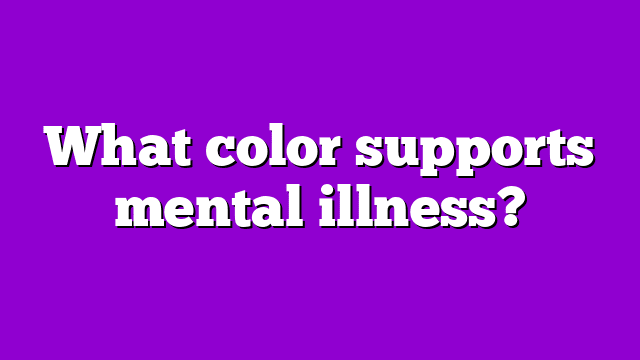Crystal Symbolism & Spirituality
What color supports mental illness?
When it comes to mental illness, there are specific colors that can help support the healing process. The color that supports mental illness is green. This calming and harmonizing color can help to ease anxiety, depression, and other mental health conditions.
On the other hand, there are a few colors that one should be wary of when it comes to mental illness. These colors can exacerbate symptoms and create a negative impact.
Here are some colors to avoid when pressing:
- Red – This high-energy color can increase feelings of anger and anxiety in individuals struggling with mental illness.
- Yellow – While it can be a happy and uplifting color, yellow can also trigger feelings of restlessness and anxiousness.
- Black – This powerful and dark color can be overwhelming for some individuals and can lead to feelings of sadness and hopelessness.
It’s important to note that everyone’s reactions to colors can be different. It’s essential to listen to your body and take note of how certain colors make you feel. By avoiding certain colors and embracing supporting hues, you can promote mental wellness and overall well-being.
Table Of Contents
- 1 Colors that Promote Mental Wellness
- 2 The Healing Power of Blue
- 3 How Green Aids in Reducing Anxiety
- 4 Yellow to Boost Self-Esteem
- 5 Red Flags: Colors that can Trigger Mental Illness
- 6 The Dangerous Side of Vibrant Shades
- 7 Understanding Color Triggers and Precautions to Take
- 8 Finding Balance: Using Colors Mindfully in Mental Health Treatment
Colors that Promote Mental Wellness
Colors can have a profound impact on our mental health and well-being. While there is no one-size-fits-all solution, studies have shown that certain colors can promote a positive mood and a sense of calm. Let’s take a closer look at some of the colors that can support mental wellness and how to incorporate them into our daily lives.
The Healing Power of Blue
Blue is often associated with feelings of calmness and tranquility. It is known to have a soothing effect on the mind and body, which makes it an ideal color for supporting mental wellness. Blue is also believed to promote creativity and self-expression. If you’re looking to incorporate more blue into your life, consider painting your bedroom a soft shade of blue, introducing blue accents into your decor, or even adding a blue scarf or piece of jewelry to your outfit.
How Green Aids in Reducing Anxiety
Green is another color that can promote a sense of calm and reduce anxiety. It is often associated with nature and the outdoors, which can help us feel grounded and connected to the world around us. Green is also believed to be a healing color, which can support physical and emotional recovery. To incorporate more green into your life, try going for a walk in nature, adding plants to your living space, or wearing a green shirt or accessory.
Yellow to Boost Self-Esteem
Yellow is a warm and uplifting color that is known to boost self-esteem and promote a positive outlook. It is often associated with happiness and joy, making it an ideal color for those struggling with depression or low self-esteem. Yellow is also believed to stimulate the mind and increase creativity. To incorporate more yellow into your life, try wearing a yellow shirt or accessory, adding yellow flowers to your living space, or painting your kitchen or dining room a sunny shade of yellow.
Red Flags: Colors that can Trigger Mental Illness
While certain colors can support mental wellness, others can have the opposite effect. It is important to be aware of colors that can trigger mental illness and to take precautions to avoid them. Let’s take a closer look at some of the colors that can be red flags for those struggling with mental health issues.
The Dangerous Side of Vibrant Shades
Vibrant and bold colors can be energizing and exciting, but they can also be overwhelming for those with mental health challenges. Colors like red, orange, and neon shades can be triggers for anxiety, ADHD, and other mental health issues. It’s important to be mindful of the colors you surround yourself with and to take precautions to avoid overwhelming and triggering shades.
Understanding Color Triggers and Precautions to Take
It’s important to understand your personal color triggers and take precautions to avoid them. If you know that bright colors make you feel anxious or overwhelmed, try incorporating more calming shades into your living space and wardrobe. Similarly, if you know that certain colors trigger negative emotions, it may be best to avoid them altogether. Remember, everyone’s experience with color is unique, so it’s important to be mindful of your own triggers and take steps to prioritize your mental wellness.
Finding Balance: Using Colors Mindfully in Mental Health Treatment
While it’s important to be mindful of color triggers, it’s also important to recognize the benefits of color therapy in mental health treatment. In fact, certain shades and hues have been found to be effective in reducing symptoms of anxiety, depression, and other mental health challenges. When used mindfully and in conjunction with other treatment modalities, color therapy can be a powerful tool for promoting mental wellness and balance.
In conclusion, colors play a powerful role in our mental health and well-being. By incorporating colors that support mental wellness and being mindful of color triggers, we can take steps to prioritize our mental health and create a more balanced and positive environment for ourselves.

